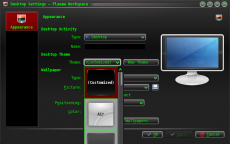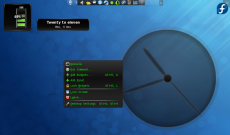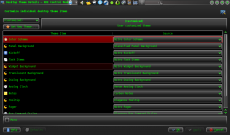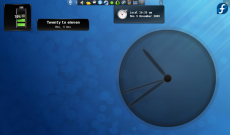工具箱
添加介紹截圖和描述
我們編寫程式的頂層頁面盡量以截圖和描述開始。具體實現代碼是
{|class="tablecenter vertical-centered"
|[[Image:你上傳的截圖.png|250px|thumb]]
|描述
|}
格式化你的文字
使用標題
Each headings goes on its own line starting and ending with two or more '=' characters. Once there are more than a handful of headings on a page they automatically create a Table of Contents, so use them. The number of '=' characters determines their level in the Table of Contents, thus your headings should be '==Main section name==', '===Subsection name===', '====Sub-subheading name here====', and so on. Avoid using single '=', as that denotes a page heading and every wiki page already has one made from its name; for example, this page's title "Toolbox/zh-tw" appears as its page heading.
使用粗體和斜體
用點(Blips)來指定粗體和斜體文字。
用'''粗體文本'''(3個'符號)指定粗體文本以及''斜體文本''(2個'符號)指定斜體文本(中文的話還可以用「文本」來區分文字)。
為了確保我們之後的翻譯輕松和准確,請遵守字體排印指導方針(涉及到文章的易讀性)。
加入程式碼片段
We have templates to assist in correctly displaying code snippets. Examples of use in various situations are available on the typographical guideline page
If you have problems displaying pipe characters in your code snippet, please see the explanation and markup detailed on Typographical Guidelines
添加縮進
- ":" is used for an indent, and was used in multiples in some old pages. This is deprecated, and causes some problems, so the multiples will be removed as they are found. A single ":" indents by four characters.
Format Dates
Dates in a purely numerical format cause confusion, due to differences in expectations of geographical zones. Please format dates as
18 Mar 2011
with the month either spelled out completely or in abbreviated form, and the year in 4-digit format. The day may be single or double-digit.
符號列表(bulleted)
*是個用來做符號列表的符號。 **是表示第二層次:
* Almonds
* Nuts
** Cashews
* Raisins
顯示效果
- Almonds
- Nuts
- Cashews
- Raisins
Enumerations
編號列表用同樣的方式生成,用'#'。
# Sift
# Mix
## Stir thoroughly
# Bake
顯示效果
- Sift
- Mix
- Stir thoroughly
- Bake
Combining Bulleted Lists and Enumerations
You can have an enumerated sublist in a bulleted list and vice versa, like this:
* Nuts
*# Cashew
*# Crazy
* Other things
顯示效果
- Nuts
- Cashew
- Crazy
- Other things
while
# Nuts
#* Cashew
#* Crazy
# Other things
顯示效果
- Nuts
- Cashew
- Crazy
- Other things
To get each bullet and each sub bullet in its own translation unit you can enter something like this:
* First bullet</translate>
<translate>
** First sub bullet</translate>
<translate>
** Another sub bullet<br /><br />This one consists of two paragraphs</translate>
<translate>
* The next main bullet</translate>
<translate>
** And so on
This displays like this:
- First bullet
- First sub bullet
- Another sub bullet
This one consists of two paragraphs
- The next main bullet
- And so on
The same method should apply to the other kinds of lists.
If on the other hand you need to have more sections in the same item, you can do something like this to have each section in a translation unit of its own:
* First bullet</translate>
<translate>
* Second bullet, first section.</translate><br /><br /><translate>Second section of the
second bullet. This section has a translation unit of its own</translate>
<translate>
* And so on
This displays like this:
- First bullet
- Second bullet, first section.
Second section of the second bullet. This section has a translation unit of its own - And so on
Itemizations
Itemizations are produced using ; and : alternatively. They are best for giving short descriptions for a group of related objects.
;Animals
: They move around and devour other creatures.
;Plants
: They have roots and feed upon ground water and sun.
produces
- Animals
- They move around and devour other creatures.
- Plants
- They have roots and feed upon ground water and sun.
加入連結
有三種類型的連結可以學,內部連結,連結到另外一個userbase頁面,和外部URL連結。
內部連結的話,你可以用這種格式[[PageLayout]],直接顯示頁面的名稱。但這種方式不太好,尤其是對于譯成docbook文檔,最好用這種形式[[PageLayout|Page Layout]],避免了翻譯者那邊的問題。你經常需要在一個句子裡包含鏈接,所以那種情況下你要用
[[Special:myLanguage/PageLayout|這個頁面]]
顯示
Internal links to subsections of a page should look like this
[[Special:myLanguage/Tasks_and_Tools#Working_with_Languages|...]]
With this kind of link it is very important, that the page you link to has a subpage anchor immediately before the section you link to. It should look like this:
</translate><span id="Working_with_Languages"></span><translate>
(in this example - the id should match the title of the section) and should be place immediately before the section headline with a blank line separating the anchor and the headline.
If the page containing the section that you link to is not yet marked up for translation, you should omit the </translate> and <translate> tags.
外部鏈接稍微有些不同,所以
[http://techbase.kde.org/Schedules 路線]
顯示
路線,直達 techbase 頁面。
最後需要注意的一點- 當你預覽你的頁面時,鏈接已經生效可以用了。這對你有兩個好處。你可以檢查(滑鼠放在連結上)是否你的連結設定的跟你期望的一樣,並且你可以用一個連結來建立一個新頁面。
Make an application list
If you want to make a list of applications like the ones in the subpages of Applications, you should use the AppItem template. Simply enter
{|
{{AppItem|System Settings/Locale|Preferences-desktop-locale.png|
Settings for localized handling of numbers, dates, etc}}A short text.
A few more short lines about the app. This is optional.
|-
{{AppItem|System Settings/Shortcuts and Gestures|Preferences-desktop-keyboard.png|
Shortcuts and Gestures}}Another short text. If you do not type <keycap>Enter</keycap> between the texts
you get one section no matter how long the text is.
|}
This gives the following display:
Settings for localized handling of numbers, dates, etc | |
| A short text.
A few more short lines about the app. This is optional. | |
Shortcuts and Gestures | |
| Another short text. If you do not type Enter between the texts you get one section no matter how long the text is. | |
Note, that you should not prepend "Special:myLanguage" to the page name - the template takes care of that. Also note, that you must give a title, even if the title is the same as the page name.
圖解你的文字
加入單張圖片,置中
[[Image:KMail-kde4.png|250px|center]]
注意你能修改圖片的位置,但默認位置是左側(left)。圖片的大小依賴於具體情況,但對於截圖,我推薦時不小於250px以及不大於500px。
使圖片可點擊,並添加標題
在你需要展示更多細節的地方,創建一張適當大小的圖片,圖可以點擊以便查看全尺寸的大圖。簡單的添加一個參數'|thumb'到圖片括號內就行。
標題也可以作為參數添加進去,但只會在提供'|thumb'的情況下顯示。
用表格精確的放置多張圖片
{|class="tablecenter" style="border: 1px solid grey;"
|[[Image:Desktop-config-customized.png|230px|center]]||[[Image:Desktop-settings-rightclick.png|230px|center]]
|-
|[[Image:Desktop-theme-details-dialog.png|230px|center]]||[[Image:Plasma-multiple-themes.png|230px|center]]
|}
顯示
 |
 |
 |
 |
注意顯示一張圖片的所有參數都要被包含在[[...]]內,而且,多個單元(不同的圖片)要用'||'分離。要開始新的一行,插入'|-'
添加附註(Notes)和警告(Warnings)
使用表格在需要加入跟你的文章有關的附註或警告的地方,像是這樣:
{{Info/zh-tw|一般提示資訊}} 顯示
{{Note/zh-tw|重要的資訊}} 顯示
{{Tip/zh-tw|需要記住的有用資訊}}顯示
{{Warning/zh-tw|這樣做很危險}} 顯示
Where the strongest possible warning is needed, the Remember box can be used, but please use sparingly. {{Remember|1=This is for things that definitely must not be forgotten}}
You can also change the heading:
程序的KDE3和KDE SC 4版本區分
默認情況下都是假定是KDE SC 4版本。如果KDE SC 4版本還沒完成發布的話,有必要去寫KDE3版本。在這種情況下,你應該添加圖標{{KDE3}},它會顯示
![]() 。要是你在同一個頁面裡寫KDE3版本和KDE SC 4版本,用這個圖標- {{KDE4}},它會顯示
。要是你在同一個頁面裡寫KDE3版本和KDE SC 4版本,用這個圖標- {{KDE4}},它會顯示
![]()
有用的模板
Inserting GUI Icons
The best way to refer to icons in the GUI is to display it in the text. This can be done with a template like this: {{Icon|list-add}}. This will display the ![]() icon.
icon.
For this to work, the icon image must have been uploaded to the wiki. See Update an Image for an explanation on how to upload images. The .png files can usually be found here: usr/share/icons/oxygen. If possible use the 16x16 icon. The file name should have an Icon- prefix as in Icon-list-add.png — apart from the prefix the filename should exactly match the usual name. Note, that when using the template you should neither write the Icon- prefix nor the .png file type extension.
The ![]() icon can also be written as
icon can also be written as {{Plus}}, and the ![]() icon as
icon as {{Minus}}. You can also use {{Configure}} to get the ![]() icon, and
icon, and {{Exit}} gets you the ![]() icon.
icon.
社群應用程式
最後關心的一點是那些並不作為核心KDE應用程序發布的程序(譯者註:大意應該是其他非KDE的社區開發的程序)。那些需要用圖標指明,放置{{Community-app/zh-tw}}
在你句子或一行的末尾,如同你在普通書寫中表示一個腳註一樣。然後你需要添加{{Community-app-footnote/zh-tw}},它會顯示腳註,像是這樣子:
對現有頁面做重大修改
If a page is likely to be open for editing for some time there is a danger of conflicts - someone else may edit at the same time, and saving your edit will cancel out theirs, or vice versa. The way to avoid that is to make a temporary entry, directly under the language bar, using {{Being_Edited}} which will display
Don't forget to remove it when you have finished!
Adding a New Complex Page
If you need to be able to work on a page for quite some time, over several days, for instance, you may like to use the Construction template - {{Construction}}, which displays
Links to Pages in the Neighbourhood
You can add links to a preceding or a following page using the following templates as described here:
{{Prevnext|Previous Pagename|Following Pagename|The page before this page|This page you should read later}}
- ← The page before this page
- Toolbox/zh-tw
- This page you should read later →
For first pages with no preceeding page or last pages with no following page use this:
{{Next|Following Pagename|This page you should read later}}
- Toolbox/zh-tw
- This page you should read later →
{{Prev|Previous Pagename|The page before this page}}
- ← The page before this page
- Toolbox/zh-tw
Adding a List of Sub-Pages
== Subpages of {{FULLPAGENAME}} ==
{{Special:PrefixIndex/{{FULLPAGENAME}}/}}
is very useful when you want to list subpages with active links, such as
Subpages of Toolbox/zh-tw
It does, however, also list all "other-language" pages, so use with discretion.







